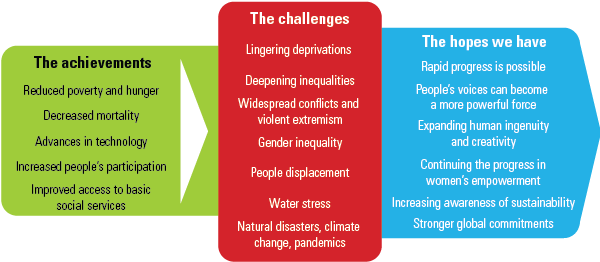

Introduction
In past decades, there has been significant gains in human development levels in almost every country; but millions of people have not benefited from this progress. Who has been left behind and why? The Human Development Report 2016 ’Human Development for Everyone’ looks into these two questions. It identifies recognizes that in every society certain groups are far more likely to suffer disadvantages than others and identifies deep-rooted, and often unmeasured, barriers to development.
The report also looks to what societies should do to advance human development for everyone. It sets forward policy recommendations at the national level and also looks at ways in which the global development landscape could be made more effective in the fight to leave no one behind and achieve the 2030 Agenda and the Sustainable Development Goals (SDGs).
Chapter 1: Human development—achievements, challenges and hopes
During the past quarter of a century, there has been impressive progress on many fronts of human development, but the gains have not enriched every human life.

What humanity has achieved over 25 years despite all the challenges it has faced gives hope that fundamental change is possible. Progress on many fronts has been uneven and deprivations linger, yet what has been achieved can become a foundation for progress in many areas. We can explore new possibilities for overcoming challenges and attain what once seemed unattainable.
The chapter features a special contribution “The power of culture to prompt action” by Olafur Eliasson, artist and founder of Little Sun.
Chapter 2: Universalism—from principles to practice
Universalism is key to human development, and human development for everyone is attainable. Various groups of people still suffer from basic deprivations and face substantial barriers to overcoming them.
Those groups who remain deprived may be the most difficult to reach—geographically, politically, socially and economically. Surmounting the barriers may require greater fiscal resources and development assistance, continuing gains in technology and better data for monitoring and evaluation.

The average human development achievements of countries mask a more complex picture. Disaggregated data shows that in developing and developed societies, many people are being left behind.
The chapter features a special contribution “Getting a clearer picture of poverty” by Melinda Gates, co-chair of the Bill & Melinda Gates Foundation.
Chapter 3: Reaching everyone—analytical and assessment issues
Chapter 3 asserts that achieving human development for everyone requires a change in the way human development is measured and examine more closely not just what has been achieved, but by whom, how, and to what effect? Who has been excluded and why? This requires disaggregation of data for characteristics such as place, gender, and ethnicity; focus on quality of achievements, not only the quantity; disaggregation of data on such characteristics as place, gender, socioeconomic status and ethnicity; and inclusion of emerging data resources, including big data to complement the traditional statistical methods
It is also important to emphasize some principles to ensure that human development reaches everyone.

The chapter features a special contribution “Predictably irrational—helping advance human development in a less than rational world” by Dan Ariely, James B. Duke Professor of Psychology and Behavioral Economics at Duke University.
Chapter 4: Caring for those left out—national policy options
Chapter 4 presents a four pronged national policy approach can ensure that human development reaches everyone. – First reorient universal human development policies to reach to those left out, second, take specific measures for groups with special needs (e.g. persons with disabilities), third, implement strategies to make human development resilient and fourth, provide voice and autonomy to those left out.

The chapter features a special contribution “The world has much to learn from indigenous peoples” by Mirna Cunningham Kain, Nicaraguan Miskitu, indigenous peoples rights activist and former chairperson of the United Nations Permanent Forum on Indigenous Issues.
Chapter 5: Transforming global institutions
Chapter 5 argues that global institutional reforms and a fairer multilateral system would help attain human development for everyone. Reforms should encompass the regulation of global markets, the governance of multilateral institutions and the strengthening of global civil society.
The chapter features a special contribution “Preventing violent extremism and promoting human development for all: A critical issue on the global development agenda” by Carol Bellamy, chair of the Governing Board of the Global Community Engagement and Resilience Fund and former executive director of the United Nations Children’s Fund

Chapter 6: Human development for everyone—looking forward
Human development for everyone is attainable. We can build on what we have achieved, we can explore new possibilities and we can attain what once seemed unattainable. Hopes are within our reach to realize.
A five-point action agenda can facilitate moving towards the goal of human development for everyone.

The chapter features a special contribution “The Sustainable Development Goals—shared vision, collective responsibilities” by Dr. Angela Merkel, Chancellor of the Federal Republic of Germany
Statistical annex
The report features 16 statistical tables in the annex as well as the statistical tables following chapters 2, 4 and 6 provide an overview of key aspects of human development. The first seven tables contain the family of composite human development indices and their components estimated by the HDRO. The remaining tables present a broader set of indicators related to human development.
Unless otherwise specified in the notes, tables use data available to the HDRO as of 21 March 2017. All indices and indicators, along with technical notes on the calculation of composite indices and additional source information, are available online at http://hdr.undp.org/en/data.
Countries and territories are ranked by 2015 Human Development Index (HDI) value. Robustness and reliability analysis has shown that for most countries the differences in HDI are not statistically significant at the fourth decimal place. For this reason countries with the same HDI value at three decimal places are listed with tied ranks.
